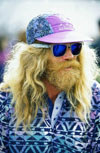Profile: Bob Athey, Utah
Avalanche Observer
From Passion to Profession – 30 Years of Skiing
the Greatest Snow on Earth
by Kersten Swinyard
As the only full-time observer employed by the Utah
Avalanche Forecast Center, Bob Athey gets paid for
reporting what he sees each of the 120 days a year he
backcountry skis in the Wasatch Mountains east of Salt
Lake City.
“I was going to be a lawyer,
but I discovered powder snow,” Athey says. “So I went
skiing instead, and have been working on a different
education.”
Part of that education has been in
tax law, apparently, as Athey now deducts work expenses
from tax returns – meaning he gets to write off new
skis, poles, packs, hats, gloves and any other gear he
needs to work. It’s a ski bum’s dream.
“It
takes a long time to be a good ski bum,” Athey chuckles.
“You have to have fairly low goals,
too.”
His first ski tour was sometime
around 1975, give or take a few years – he doesn’t
exactly remember. In those early days, Athey split
his time between sporadic class attendance at the
University of Utah and less sporadic backcountry skiing.
The erstwhile sociology major earned his degree in 1981,
10 years after enrolling in his first college
class.
But it’s not his book smarts that
made him famous along Salt Lake’s Wasatch
Front.
Decades of 100+ day seasons have
created a legend of the mellow 50-year-old with an old
school look. His blond, white and red hair frays out
from under a heli free hat and down past his shoulders; his swirling
winter beard nips the collar of a plaid half-zip flannel
shirt.
 click to view larger pic. click to view larger pic.
Athey spends
at least five days a week, six months out of the year
touring in the Wasatch mountains and analyzing its
snowpack. But even when pressed, Athey can’t nail down a
favorite slope or touring area.
“People are
so fussy about snow,” Athey says. “If there isn’t a
100-inch base at Alta, no one goes
skiing.”
He’s not picky about inch depths,
and groans when asked about the below-average snowfall
this season. The snow near Salt Lake City – even in
sparse years like the last few that have plagued Utah
with a severe drought – is good enough for a solid
season.
Athey started touring on telemark
skis because that was his only option in those
days. Now he rotates among 10 different setups, from
randonnee to telemark to a split
snowboard.
Did skiers flock to the
backcountry because the gear improved, or did the gear
improve because skiers demanded it? Either way, Athey
has noticed the significant increase in backcountry
traffic.
He claims that he’s mellowed
considerably in his relatively old age, but he still
quickens his speech and peppers it with more obscenity
than usual when he mentions high-marking snowmobiles and
helicopter skiing operations.
But a few
seconds later, he’s back to his affable
twang.
Rather than maintain any anger
toward ‘bilers or heli-skiers, Athey simply retreats
farther into the canyons, or he’ll just ski the terrain
before the helicopters set down.
Besides,
even though he thinks snowmobiles are noisy and stinky,
he realizes that “some people would say that about me,
too.”
Athey sometimes moonlights by
teaching avalanche safety courses in the evenings, but
he keeps quiet hours.
Lately his nights
have been occupied by fiddling with his first computer,
bought at a recent close-out sale. He decided to plunge
into technology to better communicate with the avalanche
forecast center and to post photos of
slides.
Athey’s observations help the
forecast center determine daily avalanche warnings. But
he rarely avoids touring when avalanche danger is high.
Rather, he relishes it because there are fewer people.
Also, “the best days to learn about avalanches are when
avalanches are happening,” Athey says.
He
has deliberately and safely triggered many avalanches by
kicking cornices off the tops of ridges, but he’s only
been unintentionally caught in a few small slides,
including one that wrapped him around an aspen
tree.
His most recent close call was
last winter when Athey avoided a five-foot deep
avalanche by only a few seconds. After he and a friend
chose one side of a ridge, the other slope stress
fractured, and “the whole bowl we decided not to ski
avalanched out,” he says.
Athey claims
that he’s too jaded to describe a perfect day of skiing,
and he doesn’t use hyperbole to describe the good times.
It’s simple and straightforward to him:
“Easy trail breaking, face-shot powder, and you make it
home to ski another day.”
Retiring is
nowhere in his plans. A few weeks ago, Athey ran into a
friend on the approach to Red Baldy southeast of Salt
Lake.
“There were about 10 people skiing
up there, and me and old George were the only ones who
made it to the top of Red Baldy, and he’s 80,” Athey
says. “If I’m 80 and I still get to do what George is
doing, I won’t need to retire. He still enjoys skiing,
and he’s been skiing far longer than I
have.”
Athey also hopes to continue
studying avalanches, but he realizes that the more time
he spends in the backcountry, the more likely he will
become a victim of one.
But he has a
strategy for that concern, too. He calls it the Dirty
Harry principle.
“When you stand at the top
of the hill and you’ve done all your stability analysis
and you’re getting ready to ski, the last thing you ask
yourself before you head down the hill is, ‘do I feel
lucky?’” Athey says.
So far, so
good.
|